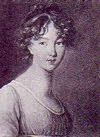
Knitting is my primary passion when it comes to handwork. It is the first kind of handwork I learned, growing up in a knitting household and being taught when I was about five years old. I knit very simple (and often odd-looking) garter stitch items for my dolls and stuffed animals and then around age ten, began to knit hats, gloves (two flat sides with cast ons and cast offs for fingers and then sewn together), scarves for myself and family members. This led to Arans in my early teens and any other type of stitch variation I could learn and use. At the same time, from about age eight onwards, I was clumsily constructing doll clothes of all sizes. None of these, rightly so, have survived but some of my early tandem attempts at stitchery have in various conditions. This is all leading up to explain that a lifetime surrounded with wool, embroidery floss, fabric, linen, canvas and needles of all sizes and shapes has refined itself into a concentration on knitting, quilting, Irish/flame/bargello and cross stichery, most of which has a lean towards reproduction.
I have no other electronic venue to display my work, apart from Ravelry, so I have decided to sprinkle this blog with an occasional piece of alternative handwork. Since today is the birthday of Jane Austen (235 years young), and she is, for many reasons, my most revered author of all time, I have posted a picture of a white work quilt I made in the late 1990s. It was also my first and last attempt at appliqué, an technique obviously to be ranked with my limited skills in drawing. I do, however, greatly enjoy wholecloth quilting. As much as I am in love with printed fabrics, I think my favourite part of the quilt making process is the quilting which comes at the end, and which, like the rest of the production, I do by hand. This little quilt, measuring approximately 20” x 14”, was marked in light pencil using two different stencils. It may not be very apparent but there is stippling (tiny squiggly stitches) all around the appliquéd piece. Another first and last experience as stippling was not unlike knitting the Peterson’s garter stitch hood or flying for many, many hours. Millions of stitches in a feeling of suspended animation, in a twilight zone where nothing seems to be advancing towards completion.
As with almost every kind of stitchery, except knitting, I am self-taught and perhaps that was not a wise choice when it came to appliqué. Nevertheless, after reading and practicing, I chose the classic silhouette image purported to be of Jane Austen and owned by the National Portrait Gallery in London. The fabric is a an imitation silk; the rest of the quilt is made from 100% cotton and the batting/wadding is Fairfield Soft Touch cotton. I use this and Warm and Natural Needled Cotton Batting for my reproduction quilts as they result in a fairly similar texture to the cotton or combed fleece fillings used in the past. They are also pure heaven to stitch through.
This quilt is, however, not a reproduction but a tribute one using cross-hatching, stippling and feathers as motifs reflecting the complexity and yet seemingly effortless gracefulness of Jane Austen’s writing.


No comments:
Post a Comment